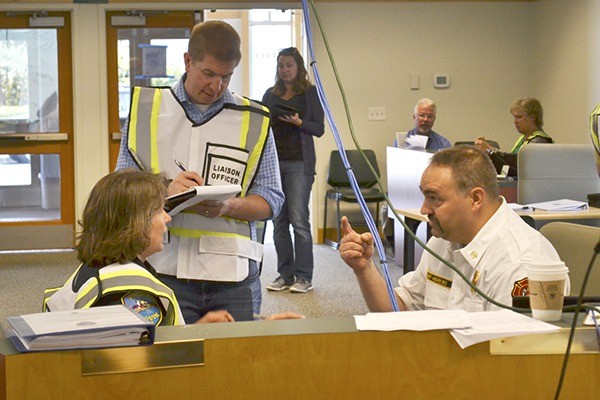As most residents move through their day-to-day life, a mix of local, state, tribal and federal emergency responders are preparing for an expected catastrophic earthquake and tsunami.
The widespread, multi-state exercise known as Cascadia Rising is named in recognition of the Cascadia Subduction Zone — a roughly 800-mile long fault offshore of the California, Oregon, Washington and southern British Columbia coastlines. The fault marks where the smaller Juan de Fuca plate is slipping beneath the North American plate, which causes periodic, major tremors every 200-500 years.
Geological evidence suggests the last 9.0 magnitude-plus earthquake occurred in 1700 and therefore emergency officials are readying for the worst. Secondary effects associated with a major earthquake and tsunami could include landslides, avalanches, gas leaks, liquefaction, fires, flooding, hazardous material release, low level contamination in inundation areas, lack of food and water and disease.
Given the complex natural disaster scenario tied to the Cascadia Subduction Zone, from June 7-10, Cascadia Rising combines a variety of tabletop and functional exercises to help prepare from the neighborhood to the national level.
City impact
In the City of Sequim, simulated devastation ranged from electricity and radios going out to elderly residents being trapped in an elevator.Multiple agencies operated out of the city’s Emergency Operations Center in the Sequim Transit Center, 190 W. Cedar St., from June 7-8.
Inside, city councilors considered declaring a state of emergency, first responders compiled and enforced tactical information on the devastation and city staff worked on a multitude of issues from finances to planning.
Sequim Police Deputy Chief Sheri Crain, who served as incident commander, told Sequim city councilors that the “ground shook for a long time and there’s a lot of bad stuff going on out there.”
Crain said the police don’t have the capacity to check on the community on a large scale, so she encouraged city councilors to go into their neighborhoods and check on residents.
Police Chief Bill Dickinson, who served as controller issuing incidents for the teams to handle, said one thing they want to educate the public about is that when they see an emergency vehicle at first during an emergency, they can’t stop right away because they are trying to assess the problems.
“They’re doing a triage of seeing what’s out there,” he said.
Sequim Police Officers John Southard and Rick Larsen served as liaison officers for the Washington Army National Guard with the Special Operations Detachment.
Southard said they support the incident commander with planning and to prepare for incoming support from the National Guard.
Larsen said their role wouldn’t be to take over but to provide a support role with manpower, medical support and supplies.
Southard and Larsen are one of many local National Guardsmen who will report to local emergency operation centers like Sequim.
Looking at the overall Sequim operation, Mayor Dennis Smith said the exercise training was necessary.
“It’s nice to have some idea of what the departments are doing,” he said.
City Councilor Genaveve Starr agreed saying, “Everyone seems to be taking it like it’s a serious event.”
Other exercises
The City of Sequim is “playing” for two of the four-day exercise, but Clallam County is participating through Friday, June 10, said Penelope Linterman, Clallam County Sheriff’s Office Emergency Management Division program coordinator.
Throughout Cascadia Rising, Linterman is acting as manager of the Joint Information Center (JIC) where all communication from across the county is funneled. The JIC is located in the Clallam County Courthouse.
“The role of the JIC is to monitor all news, any communication and disseminate news so it’s one voice reporting to the state,” she said. “It’s intended to act as a single point of contact.”
In Carlsborg, a team of officials with the U.S. Armed Forces from Delaware have set up and are operating a Joint Incident Site Communications Capability (JISCC) package in Carlsborg.
The JISCC is a “self-contained package” that allows emergency responders to communicate via phone, Internet and radio, said U.S. Air Force Chief Dan Stine.
“The idea is we can show up first when all communication is down, set up and re-establish communication,” he said.
Poor communication during and following Hurricane Katrina spurred the need for a national program and JISCC system, Stine explained. Being able to simulate an emergency response effort and in doing so use a JISCC is important because “you don’t know all the issues with a system like this until you take it on the road.”
Another JISCC from Spokane was set up in Port Angeles at the William R. Fairchild International Airport.
On Friday, June 10, an air rescue is planned to take place from the Carlsborg location, but no time has been scheduled.
Additional exercises slated as part of Cascadia Rising include, but aren’t limited to, a walking evacuation of downtown Port Angeles, a Hazardous Materials Decontamination (HAZMAT) Drill at the Port of Port Angeles and a Reverse Community Point of Distribution (CPOD) food drive hosted by Clallam County Fire District 5 in Clallam Bay. At the individual and community level, participants of the Clallam County Emergency Management Division’s “Map Your Neighborhood” program also may practice procedures to inspect and secure their neighborhood.
Following Cascadia Rising, a local, state and national “after action report” will be written to help emergency responders identify areas of improvement, Linterman said.


